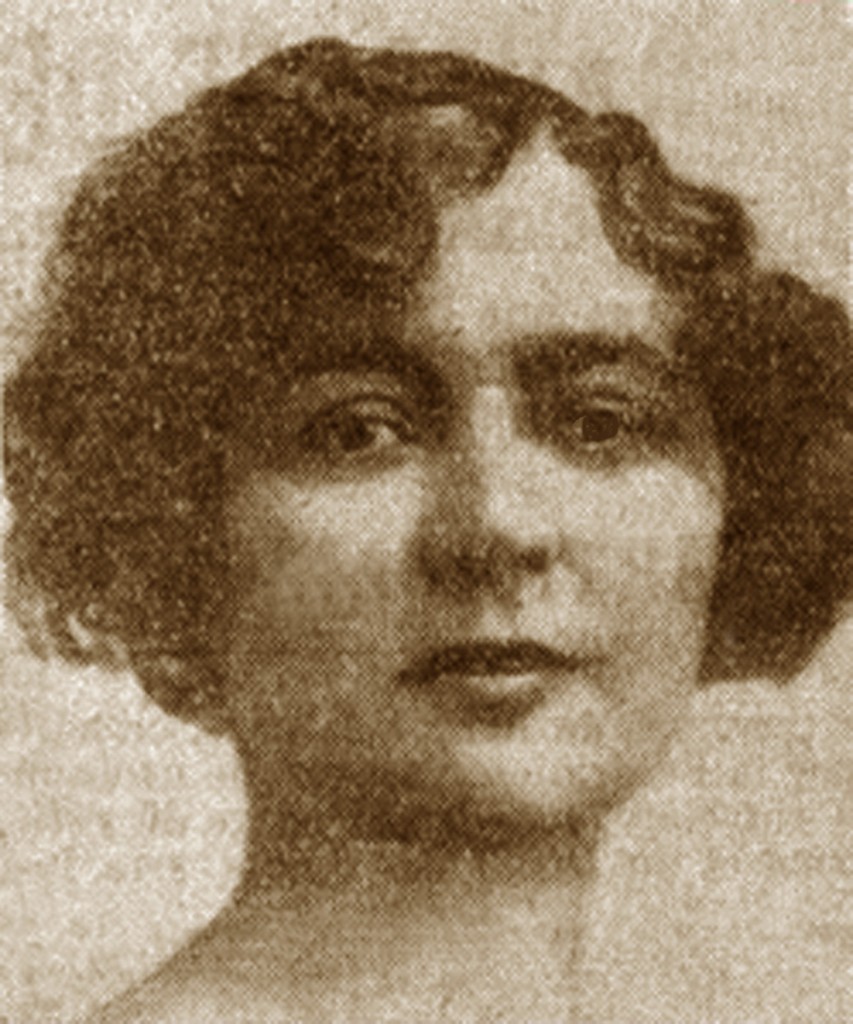
Madame de la Souchère pictured in Le Petit Parisien of 18 August 1922,when she received the Chevalier de la legion d’honneur
This article was published previously in Saigoneer http://saigoneer.com/
There can be few more fascinating figures in the history of colonial Saigon than Madame Janie-Marie Marguerite Bertin Rivière de la Souchère (1881-1963), the widow who defied the social conventions of her time to become an immensely rich yet caring rubber plantation owner – only to lose everything in the Great Depression.
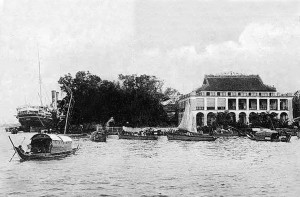
The Messageries maritimes where Charles Rivière de la Souchère worked as a river pilot
In 1901, following a conventional upbringing in Pays de Caux (Haute Normandie), Janie-Marie Marguerite Bertin married a young merchant marine officer named Charles Rivière de la Souchère. Five years her senior, Charles was keen to pursue a career overseas, and in 1904 the 23-year-old Madame de la Souchère followed him to Cochinchina, where he had been offered employment with the Service du pilotage on the Saigon river. By November 1905, Charles was a fully qualified pilot based at the Messageries maritimes. The couple immersed themselves in the Saigon social scene, becoming regulars at the popular Cercle des Officiers.
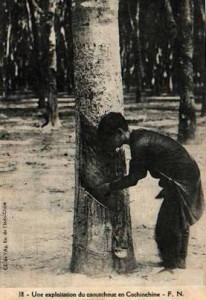
Rubber tapping – extraction of latex from rubber trees – in colonial Indochina
However, Janie-Marie quickly became bored with the suffocating routine of colonial life in the city and in 1909 she persuaded her husband to purchase 300 hectares of land at Long Thành, 55km northeast of Saigon. In the following year, supported by a small army of workers, she personally set to work carving a rubber plantation out of the virgin forest.
These early efforts were not without problems – at the outset, wild tigers decimated her workforce and in 1913 a massive fire destroyed her entire crop of 50,000 rubber saplings. Undaunted, Janie-Marie simply started over. By 1914 she had turned the “Plantations du Tan-Loc” into a going concern.
Tragedy struck in 1916, when Charles died suddenly after a short illness. Despite her heartbreak, Janie-Marie became more determined than ever to make the plantation a success. She first appears later that year in the official records in place of her husband as the proprietor and director of the Société des plantations des Hévéas de la Souchère. By 1917 Janie-Marie had also succeeded Charles to become the first female member of the Syndicat des planteurs de Caoutchouc (Rubber Planters’ Syndicate) and of the Chambre d’Agriculture de la Cochinchine.
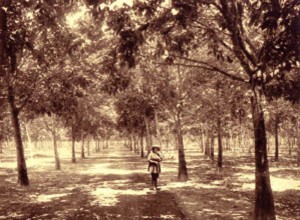
Madame de la Souchère pictured on her plantation (source: http://belleindochine.free.fr)
Over the next decade, Janie-Marie’s business prospered and by the early 1920s the “domaine de la Souchère” embraced more than 3,000 hectares of land in Long Thành and Xuân Lộc. With a European manager and a local workforce of more than 800, the plantation was “divided by wide avenues” and contained more than 170,000 rubber trees, 25,000 coconut trees and 10,000 coffee plants.
A proficient Vietnamese speaker, Madame de la Souchère was said to have enjoyed the respect and loyalty of all her workers, whom she treated like an extended family. She built a health centre, a nursery, a primary school, a pagoda and a church on the plantation for their use, and also had a villa constructed in Cap Saint-Jacques (Vũng Tàu) where sick workers could be sent for rest and recuperation. She set up a savings scheme for her employees and is said to have taken such a personal interest in their welfare that “the name of the Souchère was revered by hundreds of Annamite families.” She even gave 12,000 piastres to the local provincial chief to build a maternity clinic and dispensary on the plantation which could be used by the wider community. In the 1920s, she adopted several local orphans who eventually went to live with her in France.
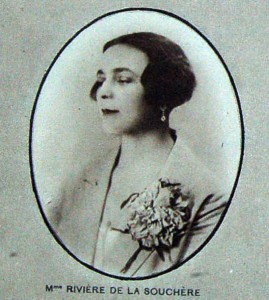
A portrait of Madame Rivière de la Souchère (source: http://belleindochine.free.fr)
In 1922 she became Vice President of the Rubber Planters Association and in that same year she was awarded the Chevalier de la legion d’honneur for her contribution to the economy and her philanthropic work towards the community in Long Thành and Xuân Lộc.
Madame de la Souchère also found time to campaign actively for women’s rights, lobbying the Colonial Council in 1923 for “French women and indigenous women who could write” to be permitted to vote in elections.
A noted beauty who loved to dress in men’s tropical whites, Madame de la Souchère has often been cited as the model for the character of Éliane Devries, proprietor of the 6,000 hectare Lang-Sai plantation, who was played by Cathérine Deneuve in Régis Wargnier’s 1992 film Indochine.
In 1926, after years of living in basic accommodation, Madame de la Souchère decided to build herself a comfortable villa on the plantation. Then in 1927, perhaps wanting to spend more time in the city, she also commissioned the construction of a grand mansion at 169 rue Mac-Mahon (now 169 Nam Kỳ Khởi Nghĩa) in Saigon. However, she was given little time to enjoy these properties – in 1930, the economic crisis hit Indochina, and as the price of rubber crashed, Madame de la Souchère became mired in debt.
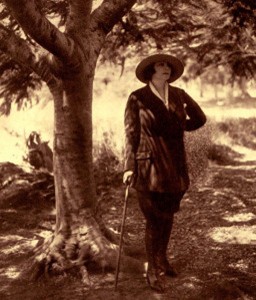
Madame de la Souchère pictured on her plantation (source: http://belleindochine.free.fr)
In an interview she gave for Henriette Célariè’s 1937 book Promenade en Indochine, Madame de la Souchère admitted that in addition to being a victim of the economic downturn, she considered herself partly to blame for her predicament: “During the period of prosperity I experienced the thrill which comes with the influx of money and distributed a great deal of it in welfare. Nothing was too good, nothing was too expensive.”
Many advised her to sell up and leave, but she decided to stay, convinced that she could weather the storm. And in so doing she lost everything.
During this difficult period, the Bank of Indochina showed no leniency towards debtors and wasted no time seizing real estate and other forms of collateral upon defaulted debt. On 28 September 1933 the entire Souchère plantation, valued in 1929 at around 2 million piastres, was sold to the bank for just 100,000 piastres.
In October 1933, Chantecler magazine reported a strongly worded complaint from the Syndicat des planteurs de Caoutchouc to the Governor General about the scandalous sale of Madame de la Souchère’s “magnificent estate,” expressing outrage that “so many years of hard work and courageous tenacity which won the admiration of everyone towards this wonderful French woman… ends up with this.”
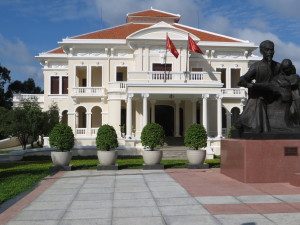
Madame de la Souchère’s former mansion at 169 Nam Kỳ Khởi Nghĩa, now the Hồ Chí Minh City Children’s House (Tim Doling)
It went on: “Will there be left at least the field in which her husband is buried and on which stands the chapel of the plantation?” Indeed, such was the level of support for Madame de la Souchère and criticism of the Bank of Indochina’s conduct over the affair that in the following month a packed public meeting in Saigon concluded with calls for the resignation of Governor General Pierre Pasquier! But it was all in vain.
With her plantation gone and the mansion at 169 rue Mac-Mahon also repossessed by the bank, Madame de la Souchère rented a modest apartment at 213 rue Catinat and set to work finding gainful employment. Over the next few years she worked variously as a representative of the Agence Immobilière de l’Indochine, as administrator at the 100-hectare Société des Plantations de Thai-Binh, and from 1934 as Inspector of Women’s Labour for the Cochinchina government. Remarkably, by 1936 she had cleared her debts and later in that year she even had enough money to purchase a modest 200-hectare coffee and rubber plantation in Biên Hòa.
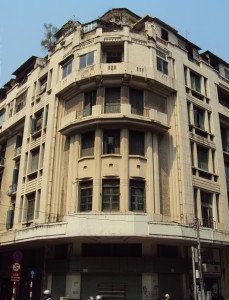
Madame de la Souchère’s last residence in Saigon, 213 Đồng Khởi (Tim Doling)
In 1937 the Syndicat des planteurs made Madame de la Souchère their Honorary President at a special ceremony in which the speaker noted her past misfortunes and said: “It is painful to note that the state bank could set such an example of disregard for the law and misappropriation of its debtors’ funds for its own benefit and to the detriment of the community.”
Madame de la Souchère returned to France in early 1938, spending her later years at Seyne sur Mer in the Provence-Alpes-Côte d’Azur region. In 1952 she was promoted to the rank of Officier de la Légion d’honneur. After 1954 she arranged for the repatriation of her husband’s remains. She never returned to Indochina.
Janie-Marie Bertin Rivière de la Souchère died in Grasse on 31 October 1963 and was buried in the Seyne sur Mer cemetary.
Today most of the former Souchère plantation is still producing rubber, although few of the original colonial buildings have survived.
However, the Saigon mansion she built in 1927 still stands today at 169 Nam Kỳ Khởi Nghĩa. After 1933 it was rented out to various individuals and organisations until 1936, when it became the new residence of the director of the Bank of Indochina.
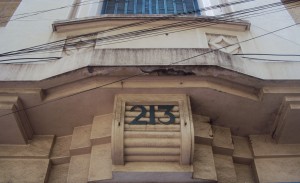
Madame de la Souchère’s last residence in Saigon, 213 Đồng Khởi (Tim Doling)
From 1945 to 1954 it was taken over by the French military, initially becoming the residence of General Philippe Leclerc (1945-1946), commander of French forces in Indochina after World War II. In the 1960s it was repurposed again, initially as the Medical and Pharmaceutical Faculty of Sài Gòn University and later as the residence of the Deputy President of the Republic of Việt Nam. After Reunification, the mansion and its grounds became the Hồ Chí Minh City Children’s House, a function it retains to this day. It recently underwent a sympathetic renovation.
Sadly, Madame de la Souchère’s last residence in Saigon – the art deco apartment block at 213 Đồng Khởi – was not afforded heritage status and was recently demolished.
Tim Doling is the author of the guidebook Exploring Saigon-Chợ Lớn – Vanishing heritage of Hồ Chí Minh City (Nhà Xuất Bản Thế Giới, Hà Nội, 2019)
A full index of all Tim’s blog articles since November 2013 is now available here.
Join the Facebook group pages Saigon-Chợ Lớn Then & Now to see historic photographs juxtaposed with new ones taken in the same locations, and Đài Quan sát Di sản Sài Gòn – Saigon Heritage Observatory for up-to-date information on conservation issues in Saigon and Chợ Lớn.


Hello, Tim–
Thanks so much for making this history accessible. My family lived on Rue Catinat 1955-56, yet I had not learned about Mme. Souchere until reading your article. Very interesting and much appreciated.
Thanks Michael with the current redevelopment plans it looks like the upper section of the street will look quite different in a few years time. Great if you are a fan of tower blocks with glass curtain walls…